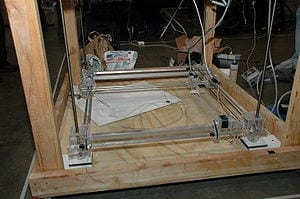A new manufacturing technique could help poor countries as well as rich ones
EVERY summer, Seattle holds a raft race in Green Lake, a park that is the eponymous home of the water the rafts must cross. Entries for the Milk Carton Derby have to be made from old plastic milk bottles. The result is a wonderfully Heath-Robinson collection of improvised craft. But this year one stood out: the entry from the University of Washington’s engineering department actually looked like a boat. The students who built it, Matthew Rogge, Bethany Weeks and Brandon Bowman, had shredded and melted their bottles, and then used a 3D printer to print themselves a plastic vessel.
No doubt the Milk-Carton-Derby rules will be tightened next year—though in the end, the team came only second. But they did come first in a competition that mattered more. On October 19th they won $100,000 in the 3D4D Challenge, organised by a charity called techfortrade.
3D printing is all the rage at the moment. Several varieties of the technique exist, using a wide range of materials as the “ink”. One of the most popular methods, though—and the one used by the team—works by extruding a filament of molten plastic. In the case of the team’s printer, this plastic was high-density polyethylene from milk bottles. The print head makes repeated passes over the thing being printed, leaving a plastic trail as it does so. It thus builds up a three-dimensional structure.
3D printing is now taken seriously by manufacturers as an alternative to cutting, bending, pressing and moulding things. It is also a popular hobby among those of a geeky disposition. What it has not been used for so far is to help people in poor countries improve their everyday lives.
Mr Rogge, Ms Weeks and Mr Bowman intend to employ their prize money to do precisely that. They plan to form a firm that will, in partnership with a charity called Water for Humans, custom-build composting toilets and rainwater collectors. The partnership will look for suitable local entrepreneurs in poor countries and will train them how to build, use and maintain the printers.
Once the technology is established for toilets and water collectors, other products will be introduced. The local partners will know what products are needed and how much people are prepared to pay for them—and therefore what is worth making. The operation will thus run on a commercial basis. But the software that controls the printers will be open-source and available to all, as will many of the designs for things the printers can make. That way, the technology can spread. A trial will begin soon in Oaxaca, Mexico.
via The Economist
The Latest Streaming News: 3D printing updated minute-by-minute
Bookmark this page and come back often
Latest NEWS
Latest VIDEO









